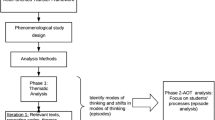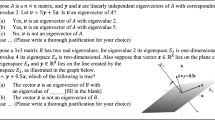Abstract
International comparative studies of education have shown that the increase in mathematical attainment differs significantly among students in relation to the different school types in which their mathematical foundations were acquired. In tertiary education, the same differences are observed with respect to simple tasks that relate to the subject matter of secondary education. Therefore, we investigate the question of whether this observation holds equally for concept construction in the field of eigen theory, by applying Dubinsky’s action, process, object, schema (APOS) theory, and Tall’s worlds of mathematics. We focus on eigen theory because we regard it as particularly representative of linear algebra in terms of its expressibility in the embodied and symbolic worlds. In our empirical study, we investigated concept constructions as correlates of educational trajectories of 36 students who covered the entire course program of a first semester mathematics course for first-year engineering students. Although significant differences in procedural knowledge were observed, results indicate that the type of secondary school does not affect concept construction among students who complete the entire course program. In our final discussion, we present implications for teaching and learning of linear algebra in heterogeneous classes and the integration of deeper learning methods into the course design.




Similar content being viewed by others
Notes
System for Teaching and Assessment using a Computer algebra Kernel
HTML5–Package, see https://h5p.org
References
Altieri, M., Paluch, D., Staupe, M., & Schirmer, E. (2019a). STACK trifft H5P—interaktives, audiovisuelles Feedback in STACK-Aufgaben basierend auf H5P. https://doi.org/10.5281/zenodo.2564881.
Altieri, M., Schellenbach, M., Schirmer, E., Opfermann, C., Kunze, J. E., Regnet, J., & Paluch, D. (2019b). Unreal Engine 4 trifft H5P und PBL—Integration einer virtuellen Realität mit interaktiven Erklärvideos in ein digitales Fachkonzept zur Unterstützung problembasierten Lernens. In M. Klinger, A. Schüler-Meyer & L. Wessel (Eds.), Hanse-Kolloquium zur Hochschuldidaktik Mathematik 2018: Beiträge zum gleichnamigen Symposium am 9. und 10. November 2018 an der Universität Duisburg-Essen. Münster: WTM-Verlag.
Arnon, I., Cottrill, J., Dubinsky, E., Oktaç, A., Fuentes, S. R., Trigueros, M., et al. (2014). APOS theory: A framework for research and curriculum development in mathematics education. New York: Springer.
Barrows, H. (2002). Is it truly possible to have such a thing as dPBL? Distance Education,23(1), 119–122. https://doi.org/10.1080/01587910220124026.
Baumert, J., Trautwein, U., & Artelt, C. (2003). Schulumwelten—Institutionelle Bedingungen des Lehrens und Lernens. In Baumert et al. (Eds.), PISA 2000—Ein differenzierter Blick auf die Länder der Bundesrepublik Deutschland (pp. 261–331). Opladen: Leske + Budrich.
Becker, M., Lüdtke, O., Trautwein, U., & Baumert, J. (2006). Leistungszuwachs in Mathematik: Evidenz für einen Schereneffekt im mehrgliedrigen Schulsystem? Zeitschrift für pädagogische Psychologie,20(4), 233–242. https://doi.org/10.1024/1010-0652.20.4.233.
Beltrán-Meneu, M. J., Murillo-Arcila, M., & Albarracín, L. (2017). Emphasizing visualization and physical applications in the study of eigenvectors and eigenvalues. Teaching Mathematics and its Applications: An International Journal of the IMA,36(3), 123–135. https://doi.org/10.1093/teamat/hrw018.
Berman, A., & Shvartsman, L. (2016). Definitions are important: The case of linear algebra. European Journal of Science and Mathematics Education,4(1), 26–32.
Bouhjar, K., Andrews-Larson, C., Haider, M., & Zandieh, M. (2018). Examining students’ procedural and conceptual understanding of eigenvectors and eigenvalues in the context of inquiry-oriented instruction. In S. Stewart, C. Andrews-Larson, A. Berman, & M. Zandieh (Eds.), Challenges and strategies in teaching linear algebra (pp. 193–216). Cham: Springer.
Caglayan, G. (2015). Making sense of eigenvalue-eigenvector relationships: Math majors’ linear algebra—Geometry connections in a dynamic environment. The Journal of Mathematical Behavior,40, 131–153. https://doi.org/10.1016/j.jmathb.2015.08.003.
Carlson, D., Johnson, C. R., Lay, D. C., & Porter, A. D. (1993). The Linear Algebra Curriculum Study Group recommendations for the first course in linear algebra. The College Mathematics Journal,24(1), 41–46.
Destatis. (2017). Schnellmeldungsergebnisse der Hochschulstatistik zu Studierenden und Studienanfänger/-innen. https://www.destatis.de/DE/Publikationen/Thematisch/BildungForschungKultur/Hochschulen/SchnellmeldungWSvorlaeufig5213103188004.pdf?__blob=publicationFile. Accessed 3 Feb 2018.
Dochy, F., Segers, M., Van den Bossche, P., & Gijbels, D. (2003). Effects of problem-based learning: A meta-analysis. Learning and instruction,13(5), 533–568.
Dubinsky, E., & McDonald, M. A. (2001). APOS: A constructivist theory of learning in undergraduate mathematics education research. In D. Holton, M. Artigue, U. Kirchgräber, J. Hillel, M. Niss, & A. Schoenfeld (Eds.), The teaching and learning of mathematics at university level: An ICMI study (pp. 273–280). Dordrecht: Kluwer.
Gijbels, D., Dochy, F., Van den Bossche, P., & Segers, M. (2005). Effects of problem-based learning: A meta-analysis from the angle of assessment. Review of Educational Research,75(1), 27–61.
Gravemeijer, K. (1999). How emergent models may foster the constitution of formal mathematics. Mathematical Thinking and Learning,1(2), 155–177.
Hannah, J., Stewart, S., & Thomas, M. (2016). Developing conceptual understanding and definitional clarity in linear algebra through the three worlds of mathematical thinking. Teaching Mathematics and its Applications: An International Journal of the IMA,35(4), 216–235.
Larson, C., Rasmussen, C., Zandieh, M., Smith, M., & Nelipovich, J. (2007). Modeling perspectives in linear algebra: A look at eigen-thinking. http://www.rume.org/crume2007/papers/larson-rasmussen-zandieh-smith-nelipovich.pdf. Accessed 22 Mar 2018.
Lesh, R., & Doerr, H. M. (2003). Foundations of a models and modeling perspective on mathematics teaching, learning, and problem solving. In R. Lesh & H. M. Doerr (Eds.), Beyond constructivism: Models and modeling perspective on mathematics teaching, learning, and problem solving (pp. 3–33). Mahwah, NJ: Lawrence Erlbaum Associates.
Lingel, K. (2013). Metakognitives Wissen Mathematik—Entwicklung und Zusammenhang mit der Mathematikleistung in der Sekundarstufe I. Dissertation, Universität Würzburg.
Lingel, K., Neuenhaus, N., Artelt, C., & Schneider, W. (2014). Der Einfluss des metakognitiven Wissens auf die Entwicklung der Mathematikleistung am Beginn der Sekundarstufe I. Journal für Mathematik-Didaktik,35(1), 49–77. https://doi.org/10.1007/s13138-013-0061-2.
Meneu, M. J. B., Arcila, M. M., & Mora, E. J. (2017). A teaching proposal for the study of eigenvectors and eigenvalues. Journal of Technology and Science Education,7(1), 100–113. https://doi.org/10.3926/jotse.260.
NMC. (2017). NMC Horizon Report > 2017 Higher Education Edition. http://cdn.nmc.org/media/2017-nmc-horizon-report-he-EN.pdf. Accessed 11 Feb 2018.
Plaxco, D., Zandieh, M., & Wawro, M. (2018). Stretch directions and stretch factors: A sequence intended to support guided reinvention of eigenvector and eigenvalue. In S. Stewart, C. Andrews-Larson, A. Berman, & M. Zandieh (Eds.), Challenges and strategies in teaching linear algebra (pp. 175–192). Cham: Springer.
Salgado, H., & Trigueros, M. (2015). Teaching eigenvalues and eigenvectors using models and APOS theory. The Journal of Mathematical Behavior,39, 100–120. https://doi.org/10.1016/j.jmathb.2015.06.005.
Sangwin, C. (2013). Computer aided assessment of mathematics. Oxford: Oxford University Press.
Schneider, W., Lingel, K., Artelt, C., & Neuenhaus, N. (2017). Metacognitive knowledge in secondary school students: Assessment, structure, and developmental change. In D. Leutner, J. Fleischer, J. Grünkorn, & E. Klieme (Eds.), Competence assessment in education (pp. 285–302). Cham: Springer.
Stewart, S. (2018). Moving between the embodied, symbolic and formal worlds of mathematical thinking with specific linear algebra tasks. In S. Stewart, C. Andrews-Larson, A. Berman, & M. Zandieh (Eds.), Challenges and strategies in teaching linear algebra (pp. 51–67). Cham: Springer.
Stewart, S., Andrews-Larson, C., Berman, A., & Zandieh, M. (Eds.). (2018). Challenges and strategies in teaching linear algebra. Cham: Springer.
Stewart, S., & Thomas, M. O. J. (2006a). Process-object difficulties in linear algebra: Eigenvalues and eigenvectors. In J. Novotná, H. Moraová, M. Krátká, & N. Stehlíková (Eds.), Proceedings 30th conference of the International Group for the Psychology of Mathematics Education (Vol. 5, pp. 185–192). Prague: PME.
Stewart, S., & Thomas, M. O. J. (2006b). Student thinking about eigenvalues and eigenvectors: Formal, symbolic and embodied notions. In P. Grootenboer, R. Zevenbergen & M. Chinnappan (Eds.), Identities, cultures and learning spaces (Proceedings of the 29th annual conference of the Mathematics Education Research Group of Australasia (Vol. 2, pp. 487–495)). Canberra: MERGA.
Stewart, S., & Thomas, M. O. J. (2010). Student learning of basis, span and linear independence in linear algebra. International Journal of Mathematical Education in Science and Technology,41(2), 173–188.
Tall, D. (2004). Building theories: The three worlds of mathematics. For the Learning of Mathematics,24(1), 29–32.
Tall, D. (2010). Perceptions, operations and proof in undergraduate mathematics. CULMS Newsletter,2, 21–28.
Thomas, M. O. J., & Stewart, S. (2011). Eigenvalues and eigenvectors: Embodied, symbolic and formal thinking. Mathematics Education Research Journal,23, 275–296. https://doi.org/10.1007/s13394-011-0016-1.
Trigueros, M. (2018). Learning linear algebra using models and conceptual activities. In S. Stewart, C. Andrews-Larson, A. Berman, & M. Zandieh (Eds.), Challenges and strategies in teaching linear algebra (pp. 29–50). Cham: Springer.
Van Ophuysen, S., & Wendt, H. (2010). Zur Veränderung der Mathematikleistung von Klasse 4 bis 6. In J. Baumert, K. Maaz, & U. Trautwein (Eds.), Bildungsentscheidungen (pp. 302–327). Wiesbaden: VS Verlag für Sozialwissenschaften.
Walker, A., & Leary, H. (2009). A problem based learning meta analysis: Differences across problem types, implementation types, disciplines, and assessment levels. Interdisciplinary Journal of Problem-based Learning,3(1), 12–43.
Warburton, K. (2003). Deep learning and education for sustainability. International Journal of Sustainability in Higher Education,4(1), 44–56.
Wawro, M., Rasmussen, C., Zandieh, M., & Larson, C. (2013). Design research within undergraduate mathematics education: An example from introductory linear algebra. In T. Plomp & N. Nieveen (Eds.), Educational Design Research—Part B: Illustrative Cases (pp. 905–925). Enschede: SLO.
Zandieh, M., Wawro, M., & Rasmussen, C. (2017). An example of inquiry in linear algebra: The roles of symbolizing and brokering. PRIMUS,27(1), 96–124. https://doi.org/10.1080/10511970.2016.1199618.
Author information
Authors and Affiliations
Corresponding author
Additional information
Publisher's Note
Springer Nature remains neutral with regard to jurisdictional claims in published maps and institutional affiliations.
Electronic supplementary material
Below is the link to the electronic supplementary material.
Rights and permissions
About this article
Cite this article
Altieri, M., Schirmer, E. Learning the concept of eigenvalues and eigenvectors: a comparative analysis of achieved concept construction in linear algebra using APOS theory among students from different educational backgrounds. ZDM Mathematics Education 51, 1125–1140 (2019). https://doi.org/10.1007/s11858-019-01074-4
Accepted:
Published:
Issue Date:
DOI: https://doi.org/10.1007/s11858-019-01074-4




